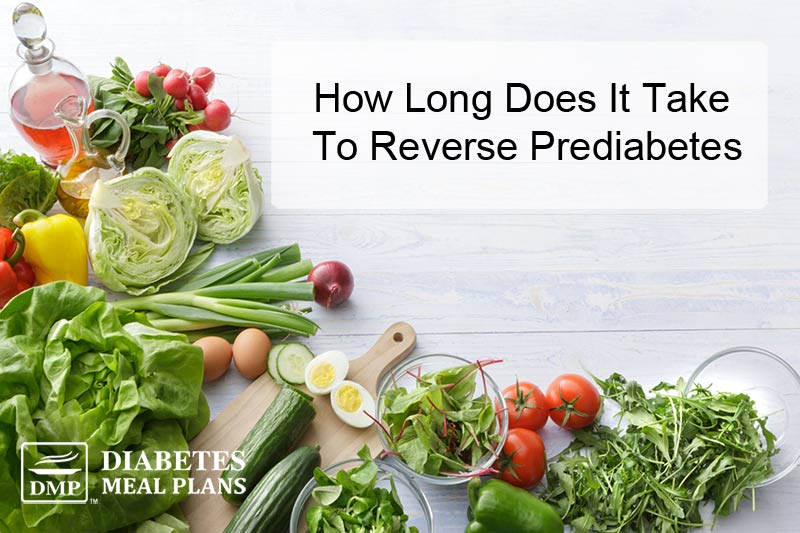Prediabetes is a condition where you’ve got higher-than-normal blood sugar levels, but not high enough to be diagnosed with type 2 diabetes.
…which means this is a great opportunity to prioritize YOU, be proactive, and reverse your prediabetes.
Certainly, reversing prediabetes is possible, in many. So let’s look closer at what that means, how long it takes, and 3 key strategies that will help you do it.

What Does Reverse Prediabetes Mean?
To “reverse prediabetes” means to bring your blood sugar levels back to a normal range and restore healthy metabolic function to your body.
Normal blood sugar levels are usually tested via A1c, so you’re looking to achieve an A1c of less than 5.7%.
Healthy metabolic function means that your body is not working well to process the food you eat, turn it into energy, and maintain a good balance of hormones and nutrients.
When it comes to prediabetes, having a healthy metabolic function means that your body is efficiently using the sugar (glucose) from your food, keeping your blood sugar levels in a normal range.
How Long Does It Take To Reverse Prediabetes?
Research studies have shown that many people with prediabetes can achieve normal blood sugar levels within 3-6 months, if they are proactive in making significant lifestyle changes.
In our experience, we can confirm this is true, as we’ve seen many of our members reverse prediabetes is possible within 3-6 months.
However, it may take a bit longer, for example, in some people it takes up to one year or more to see improvements, depending on their unique circumstances.
For example, for Cheryl, one of our members, it took a bit over one year:
“Last week I went in for my yearly physical and my A1c was 5.5! The doctor had told me that if I could keep my A1c under 5.7 for a year he would take me off metformin. So… I’m off metformin and you could say that I’m not pre diabetic anymore! I no longer experience tingling in my hands and feet. My blood pressure, and triglycerides are normal. I no longer have UTI’s and I’ve lost weight, and I feel better. Thank you DMP and your sincere staff. You are doing wonderful work. “
This is still an amazing outcome, so even if it takes you longer, keep at it – your health is worth it!
Factors That Affect The Time It Takes To Reverse Prediabetes
Factors that are going to influence the time it takes for you to achieve a normal blood sugar level are:
- Age: Younger people tend to respond more rapidly to lifestyle changes than older adults.
- Genetics: Some people may have a higher predisposition to develop prediabetes due to their genetic background, which may also affect the time it takes to reverse the condition.
- Overall health: If you have other health conditions, such as being overweight or hypertension, it may take longer to reverse prediabetes.
- Lifestyle changes: The degree that you get proactive with making the lifestyle changes you need to make can greatly affect the time it takes to reverse prediabetes.
Proactive Steps You Can Take To Reverse Prediabetes
Firstly, the most important thing is that the sooner you get proactive about taking care of your prediabetes health, the greater chance you have of reversing your prediabetes and avoiding a type 2 diabetes diagnosis and the better off you’ll be in the long term.
Then it comes down 3 key steps to reversing prediabetes:
- Physical activity
- Weight loss/management
- Diet and nutrition (most important factor!)
Physical Activity
Your body is meant to move, so anything you can do each day to move is important.
Aim for at least 150 minutes of moderate-intensity each week. This is around 30 minutes a day across 5 days of the week, which isn’t that much. If you can do more, that’s even better.
It’s also good to include different types of exercise if you can. For example, aerobic exercise, along with muscle-strengthening activities on two or more days.
Weight loss/ management
If you are overweight or obese, losing even a small percentage of your body weight (5-10%) can have a huge impact on your blood sugar levels.
Fat cells, especially those around the abdomen, release hormones and inflammatory substances that interfere with the action of insulin in your body. As a result, your body needs more insulin to maintain normal blood sugar levels.
Aim for sustainable weight loss – that’s the most important thing!
That’s what we help our members achieve – results they can maintain long term.

Prediabetes Diet
What you eat is going to be the most important thing to reversing your prediabetes!
In fact, even without exercise you can reduce blood sugar, lose weight and return your metabolic health to normal – that’s how effective diet can be!
Here’s 5 prediabetes diet tips to get you started:
- Choose high-fiber vegetables: Opt for non-starchy vegetables like leafy greens, broccoli, cauliflower, zucchini, and bell peppers, which are low in carbohydrates but high in fiber and nutrients.
- Include plentiful protein sources: Include proteins such as beef, chicken, turkey, fish, and seafood in your diet.
- Focus on healthy fats: Incorporate healthy fats like avocados, nuts, seeds, and olive oil into your meals.
- Limit refined carbs and added sugars: Avoid or reduce your intake of processed and refined carbs, such as white bread, pasta, and pastries, as well as sugary beverages and snacks.
- Opt for lower carb fruits: Choose fruits that are lower in carbohydrates, such as berries, cherries, and peaches, instead of high-carb fruits like bananas, grapes, and pineapples.
These are just general tips that form the basis of a good diet to reverse prediabetes.
If you’re interested in reversing your prediabetes, naturally with nutrition, take our clinically proven Prediabetes Reset Program.
In just 16-weeks, you will discover exactly what causes your prediabetes and exactly what to eat to return your metabolism back to normal. We’ll be here to support you all the way!
Or, to get started now, grab a copy of Dr Jedha’s recommended prediabetes food list.
References
- Knowler, W. C., Barrett-Connor, E., Fowler, S. E., Hamman, R. F., Lachin, J. M., Walker, E. A., & Nathan, D. M. (2002). Reduction in the incidence of type 2 diabetes with lifestyle intervention or metformin. The New England Journal of Medicine, 346(6), 393-403.
- Tuomilehto, J., Lindström, J., Eriksson, J. G., Valle, T. T., Hämäläinen, H., Ilanne-Parikka, P., … & Uusitupa, M. (2001). Prevention of type 2 diabetes mellitus by changes in lifestyle among subjects with impaired glucose tolerance. The New England Journal of Medicine, 344(18), 1343-1350.
- Kosaka, K., Noda, M., & Kuzuya, T. (2005). Prevention of type 2 diabetes by lifestyle intervention: a Japanese trial in IGT males. Diabetes Research and Clinical Practice, 67(2), 152-162.
- Li, G., Zhang, P., Wang, J., Gregg, E. W., Yang, W., Gong, Q., … & Shuai, Y. (2008). The long-term effect of lifestyle interventions to prevent diabetes in the China Da Qing Diabetes Prevention Study: a 20-year follow-up study. Lancet, 371(9626), 1783-1789.
- Diabetes Prevention Program Research Group. (2002). Reduction in the incidence of type 2 diabetes with lifestyle intervention or metformin. New England Journal of Medicine, 346(6), 393-403.
- Ramachandran, A., Snehalatha, C., Mary, S., Mukesh, B., Bhaskar, A. D., & Vijay, V. (2006). The Indian Diabetes Prevention Programme shows that lifestyle modification and metformin prevent type 2 diabetes in Asian Indian subjects with impaired glucose tolerance (IDPP-1). Diabetologia, 49(2), 289-297.


Leave a Reply